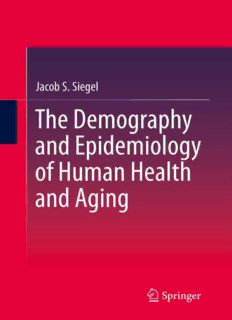
The Demography and Epidemiology of Human Health and Aging PDF
Preview The Demography and Epidemiology of Human Health and Aging
The Demography and Epidemiology of Human Health and Aging Jacob S. Siegel The Demography and Epidemiology of Human Health and Aging In consultation with S. Jay Olshansky 123 JacobS.Siegel J.StuartSiegelDemographicServices NicholsonLane5809 20852-5710NorthBethesda Maryland Unit808 USA [email protected] InConsultationwith S.JayOlshansky SchoolofPublicHealth UniversityofIllinoisatChicago WestTaylorStreet1603 60186ChicagoIllinois Room885 USA [email protected] ISBN978-94-007-1314-7 e-ISBN978-94-007-1315-4 DOI10.1007/978-94-007-1315-4 SpringerDordrechtHeidelbergLondonNewYork LibraryofCongressControlNumber:2011929938 (cid:2)c SpringerScience+BusinessMediaB.V.2012 Nopartofthisworkmaybereproduced,storedinaretrievalsystem,ortransmittedinanyformorby anymeans,electronic,mechanical,photocopying,microfilming,recordingorotherwise,withoutwritten permissionfromthePublisher,withtheexceptionofanymaterialsuppliedspecificallyforthepurpose ofbeingenteredandexecutedonacomputersystem,forexclusiveusebythepurchaserofthework. Coverdesign:eStudioCalamarS.L. Printedonacid-freepaper SpringerispartofSpringerScience+BusinessMedia(www.springer.com) To Irv,Ronnie,and Daveandourparents Preface and Acknowledgments Health demography and its companion, the epidemiology of aging, are not well definedfieldsamongthe academicareasof study.A subdisciplineof demography labeled health demography has been identified and it essentially applies the materials,methods,andperspectivesofdemographytothestudyofhealth.Health demographyoverlaps greatly with the epidemiology of aging, and the distinction mainly reflects the difference in the academic training of the analyst. This book triestosetforththebasicmaterialsofthisareaofstudyandtogiveitmoreformal definitionandscope. Healthdemographyandtheepidemiologyofagingincorporatematerialsfroma number of established disciplines, mainly sociology, demography, epidemiology, public health, gerontology, and actuarial science, but also bioethics, genetics, biostatistics,biology,medicine,geography,andcomputerscience.Althoughthelist above is long, the natural home of the subject is in departments of gerontology, demography, and epidemiology. The scope of the subject, as I envision it, is suggestedbytheTableofContentsofthebook.ItisapparentthatIcovera broad area.Thefield rangesfromthe highlytheoreticaltothe verypractical.Idealwith the theories regarding human aging and longevity, derived from molecular and evolutionary biology and biodemography, as well as with the issues involved in theexpansionofhospitalfacilitiesinacitybylocalhealthadministrators,derived fromapplieddemographyandspatialepidemiology.Iconsidertherangeoftheories regarding the question of how long humans can live, and I consider the practical problems of how to bring demographic and epidemiological methods, materials, andperspectivestoservethehealthneedsoflocalcommunities. Thebookdescribesthelatestsourcesofdataonmortalityandpopulationhealth and presents the principal research findings based on these sources. It brings together the latest methodsof measuring populationhealth phenomena,including those for mortality, morbidity, and combinations of measures of mortality and morbidity.In this connectionit considerssuch varied measuresas the manytypes of life tables, the design of health surveys, and geographic information systems for health research and administration. While maintaining a primary focus on the demographicand epidemiologicalaspects of the subjects treated, the book covers vii viii PrefaceandAcknowledgments socioeconomic variations in mortality and health, reproductive health, the health determinants and consequences of migration, health policy and administration, and selected bioethical issues. The measures described are often illustrated with examplesin the form of calculationparadigms,so that the reader hasa modelfor replicatingthe measures, andI suggestsoftwarepackagesforimplementingsome ofthemoreelaboratemethodsdescribed. The geographic scope of the text, the tabular material, and the references and suggested readings relate to both the national and international area. The health demographyofthelessdevelopedcountriesisgivenasubstantialshareofattention, indeferencetothesizeanddistinctivecharacteroftheirpopulationsandtheextent and complexity of their health problems. At the same time, primary attention is giventothepopulationhealthoftheindustrializedcountries,especiallytheUnited States,wheremostofthereadersofthisvolumeworkorwillworkasprofessional demographers,gerontologists,orepidemiologists.Ifnoothergeographicreference is given, the reader may assume that the area referred to is the United States. Nevertheless,readersfromothercountriesandstudentsofinternationalcomparative populationepidemiologywillfindmuchinitofinterestforthem. Since this book is intended to be comprehensive and interdisciplinary, it can be used as a text for courses taught in a broad range of scientific disciplines relating to population health and the epidemiology of aging, and as a reference workandhandbookfordemographers,epidemiologists,gerontologists,andpublic healthspecialistswhoworkinthisarea.Thebookisofferedasatextforadvanced undergraduate and graduate students in medical sociology, the demography and epidemiologyofaging,healthdemography,andsocialgerontology,andassupple- mentaryreadingin the instructionalprogramsof these disciplines.It should serve the needs of the many instructors who prefer a single integrated comprehensive text in the area of health demographyfor use in their courses. There is sufficient materialforatwo-semestercourse,butwithselectiveomissions,itcanbeadapted foruseinaone-semestercourse.Forshorterandlessadvancedstudyofthesubject, suchsectionsofthebookmaybeomittedasthoseonmortalitymodelsinChap.3, multistate life tables in Chap. 8, and the methods of preparing local population estimatesinChap.16,andChaps.12and17. Inasmuch as human aging/longevity is the subject of study, the reader may look for material on the characteristics of various health conditions, the risks of succumbing to them, and ways of treating them, even specific recommendations forhowtoovercomethem.Thisbookisconcernedwiththeprevalenceofdiseases andtherisksassociatedwithvarioushealthconditions,butitisnotahow-to-do-it handbookfortreatingspecificillnessesorforachievingalonglife.Itdoes,however, describetheresearchrelatingtolongevity/agingandsoimplicitlyitprovidesgeneral guidelinesforextendinghumanlongevity. Readersmaynotetheabsenceofmeasuresofreliabilityorstatisticalsignificance. Although much is said qualitatively about the accuracy of the underlying data, discussion and presentation of measures of statistical significance are omitted, partlyintheinterestsofsimplifyingthewritingandtabularpresentation.Computer software for calculatingmany of the measures in this book includethe associated measuresofsignificance. PrefaceandAcknowledgments ix It is always a matter of great interest and concern to the prospective reader to ascertain what prior technical preparation is required to take most advantage of a book of this kind. Training in some areas is essential, training in others in advisable, and training in still other areas is helpful. Training is essential in the fundamentals of statistics, and in mathematics up to the equivalent of a basic course in mathematical analysis. Courses in demographic techniques and social researchmethodsareadvisablebutnotessential,andabasiccourseinepidemiology, biostatistics, or medical sociology is helpful. A course in biostatistics provides a strong background for some of the topics treated here. Much of the material “needed”iscoveredinthisverybook,however,sinceitisintendedtobearelatively free-standingandself-containedtext. WhileIhavetriedtomakethisbookrathercomprehensiveinitsfield,itprovides only an introduction to many topics. Other related works that will extend the knowledgeofthereaderontopicsbasictothesubjectmatterofthisvolumeinclude: JacobS.Siegel&DavidA.Swanson(Eds.),Methodsandmaterialsofdemography (2nded. Elsevier/AcademicPress, 2004):Providesa comprehensivediscussionof thebasictechniquesofdemographicanalysis. RichardG.Rogers,RobertA.Hummer,&CharlesB.Nam,Livinganddyinginthe United States(AcademicPress, 2000):Givesa comprehensivepresentationof the socialandeconomicdifferentialsin adultmortalityintheUnitedStatesattheend ofthe20thcentury. S. Jay Olshansky and Bruce A. Carnes, The Quest for Immortality (W.W. Norton andCompany,2001):Presentsahighlyreadablediscussionofthefactsandfictions regardinglongevity. Louis G. Pol and Richard K. Thomas, The Demography of Health and Health Care (Second Edition, Kluwer Academic Publishers, Norwall, MA, 2000): Focuseson appliedhealth demographyand providesadditionalmaterialon health geodemography. LeonGordis,Epidemiology(ThirdEdition,Philadelphia:ElsevierSaunders,2004). StantonA.GlantzPrimerofBiostatistics(SixthEdition.NewYork:McGraw-Hill, 2007). Thesebookscanbereferredtoforfurtherdiscussionofthetoolsofdemography,the methods of epidemiologicalanalysis, and the basic issues of “longevity science.” I cover many of the same topics, but bring them together under one cover as an integrated,continuousnarrative,evenifinlessdetailedfashion. Intheinterestofexpeditingthepublicationofthebook,Idrewonsomematerial that I previously authored and that was published by Elsevier/Academic Press, to whom I express my thanks. The publications of the U.S. Census Bureau, the PopulationReferenceBureau,theWorldBank,theWorldHealthOrganization,and theUnitedNationshavebeenespeciallyhelpfulasdocumentationformanyofthe topicscoveredinthisbookandIgratefullyacknowledgemyuseofthemalso. In the preparation of this work, I was fortunate in being able to consult with S. Jay Olshansky, Professor of Epidemiology and Biostatistics, School of Public
Description: